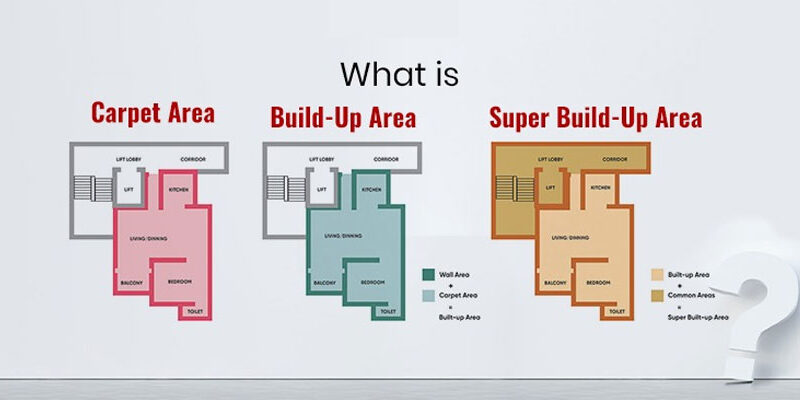Difference between Carpet Area, Built up Area & Super Area
Carpet area, built-up area, and super area are common terms in real estate, each describing different aspects of a property’s measurements. When navigating the realm of real estate, terms like Carpet Area, Built-Up Area, and Super Area play crucial roles in understanding the space you’re considering. Here’s an in-depth look at each:
1. Carpet Area:
Definition: Carpet Area refers to the usable area within the walls of an apartment or commercial unit. It excludes areas such as walls, balconies, and common spaces like staircases.
Key Points:
- Usability: Carpet Area is the actual area where you can place furniture and carpets.
- Exclusions: It does not include walls, balconies, or common areas.
- Legal Definition: Carpet Area is often defined by regulations to ensure clarity in property transactions.
Importance: Understanding Carpet Area is essential for residents as it directly impacts living space and interior design choices.
2. Built-Up Area:
Definition: Built-Up Area includes Carpet Area plus the area occupied by walls. It may also include other essential structures like balconies, but excludes common amenities such as staircases.
Key Points:
- Calculation: Built-Up Area is calculated by adding the Carpet Area to the space occupied by walls.
- Inclusions: It includes wall thickness but excludes common amenities.
Importance: Builders use Built-Up Area to price properties and determine maintenance fees, providing a comprehensive view of the constructed space.
3. Super Area (or Super Built-Up Area):
Definition: Super Area encompasses Built-Up Area and adds proportionate shares of common areas like corridors, lifts, and lobby spaces. It may also include balconies and terraces.
Key Points:
- Scope: Super Area gives a holistic view of the entire constructed area, including all common facilities.
- Calculation: It is calculated by adding the Built-Up Area to shared common areas allocated to each apartment.
Importance: Developers use Super Area for marketing and pricing properties. However, buyers should scrutinize this figure as it can include spaces not directly usable.
Key Differences:
- Exclusions: Carpet Area excludes walls and common areas, whereas Built-Up Area includes walls but excludes certain amenities. Super Area encompasses everything, including common spaces.
- Utility: Carpet Area specifies usable living space. Built-Up Area defines total constructed area including walls. Super Area provides a comprehensive overview, useful for pricing and marketing.
Understanding Carpet Area, Built-Up Area, and Super Area holds significant importance in the realm of real estate for several compelling reasons:
- Space Utilization Clarity: Grasping the concept of Carpet Area enables prospective buyers or lessees to accurately gauge the usable living space within a property. This knowledge is essential for planning furniture arrangement, storage solutions, and overall spatial comfort.
- Transparent Pricing: Developers often price properties based on Built-Up Area or Super Area. Familiarity with these metrics ensures that individuals are paying for the actual usable space and amenities provided, promoting transparency in financial transactions.
- Compliance with Regulations: Many jurisdictions have established regulations that define and standardize Carpet Area, safeguarding consumers against misleading advertisements and ensuring fair practices in property transactions.
- Maintenance and Utility Estimation: Built-Up Area and Super Area encompass various elements such as walls, common spaces, and facilities. Understanding these metrics aids in accurately estimating maintenance costs and utility requirements associated with the property.
- Facilitating Property Comparisons: Knowledge of these terms facilitates informed comparisons between different properties. This allows individuals to evaluate options based on actual usable space and amenities rather than relying solely on total area figures.
- Impact on Investment Decisions: Investors in real estate benefit from understanding these metrics as they directly influence investment potential and resale value calculations of properties.
- Navigating Legal Agreements: Contracts and legal documents pertaining to property transactions often detail these areas. Proficiency in these terms empowers individuals to negotiate terms effectively and comprehend their contractual obligations.
In essence, comprehending Carpet Area, Built-Up Area, and Super Area empowers stakeholders in the real estate market to make well-informed decisions. It ensures clarity, fairness, and informed choice-making, enhancing overall satisfaction and confidence in property transactions.

